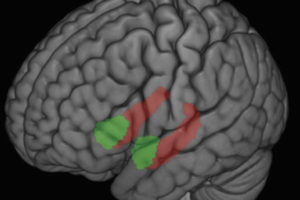Lying, fighting with others and acting disobediently are behaviors sometimes seen in preschool classrooms, but what sets the brains of children who behave this way apart from those who don’t?
That’s a question Jessica Caldwell, Center for Healthy Minds collaborator and clinical neuropsychologist at Upper Peninsula Health System-Marquette, set out to answer by unearthing links between early-life behaviors and the size of certain brain structures later in adolescence.
She and colleagues found that boys with a higher level of these externalizing behaviors in preschool had key brain structures that were smaller in volume later in life.
“Behavior in preschool, even normal variations in behavior in preschool, can have really important relationships with the structure of our brains later in life,” Caldwell says. “And then during adolescence, this is a time when we know things can go very well or things can start to go badly. It’s important to learn how that relationship works between early life and early adulthood to start understanding what puts some at risk and what protects others from mental illness.”
In the study, first published in the journal PLoSOne, she and colleagues examined data from the Wisconsin Study of Families and Work. Specifically, they examined externalizing behaviors in 76 male and female preschoolers, who later participated in a brain scan at 15 years of age. Focusing on images of the amygdala, prefrontal cortex and hippocampus – all structures of the brain that help generate and respond to emotions and behaviors, Caldwell discovered trends specific to each gender.
"There’s so much we don’t know, but it’s still worthwhile to do things like get a professional’s opinion on how to better regulate behavior in young kids if signs of externalizing behavior arise."
While boys with more externalizing behaviors were more likely to have smaller amygdala volume, girls did not show the same effect. Girls tended to have smaller hippocampus volumes in general, but this trend did not go hand-in-hand with externalizing behaviors, according to the study. This raises an interesting question about differences in brain development between boys and girls, an area Caldwell says is open for exploring further.
She also thinks the research begins to fill in a much-needed gap in understanding brain development among groups who don’t already have mental health disorders. Much of the work drawing these links has focused on extremes of the spectrum. Reduced volumes in the amygdala, for example, have been found in people diagnosed with antisocial personality disorder or psychopathy.
But Caldwell warns that it’s not known whether early behavior changes the size of these brain regions or if it’s just a correlation. Instead, she views the results as a starting point to begin paying attention to behaviors as early as possible.
“There’s so much we don’t know, but it’s still worthwhile to do things like get a professional’s opinion on how to better regulate behavior in young kids if signs of externalizing behavior arise,” she says. “We don’t know all of the risk and protective factors that lead to healthy emotional development, but just having those early externalizing behaviors could be a sign of risk. It would be worth putting protective coping skills in place, whether that comes through therapy or discussion with family.”






